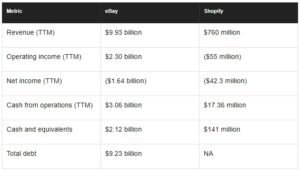Shopify (NYSE:SHOP) and eBay (NASDAQ:EBAY) are two of the many platforms positioned to succeed in a world increasingly trending toward e-commerce. While Amazon.com (NASDAQ: AMZN) may be the 800-pound gorilla in the room, there are still other ways to take advantage of the increasing growth of online sales, which has provided a fertile field for investors. In just the past three years — since its IPO — Shopify has returned an astounding 400%, compared to eBay’s 44% return, and both have beaten the S&P 500’s gains of 32%. Over the longer term, eBay has been a monster: Since its public debut in 1998, it has returned more than 4,000%.
While the rearview mirror may help provide perspective, there are no guarantees that companies will continue along their current paths, and investors want to know which is a better opportunity right now.

IMAGE SOURCE: GETTY IMAGES.
A word about the competitors
Most investors have probably heard of eBay. Founded in 1995, the company provides a platform where buyers and sellers meet to exchange goods. It’s no exaggeration to say that eBay was one of the original e-commerce sites, and is still among the largest online marketplaces in the U.S. That said, the company’s growth has slowed as e-commerce becomes more widespread, giving consumers a multitude of choices.
On the other hand, you may not have heard of Shopify. The company is a cloud-based platform that provides the tools necessary for businesses of all sizes to set up and manage an e-commerce site across multiple sales channels, including the web, social media, and brick-and-mortar stores. Shopify provides a host of ready-to-use templates and thousands of apps to build and customize a website. It can also handle invoices, credit card payments, and it can track orders by offering integration with all the major shipping companies. It’s also worth noting that merchants can use Shopify’s platform to sell goods on online marketplaces such as eBay and Amazon as well.
Recent results
In its most recent quarter, eBay’s revenue and gross merchandise volume (GMV) grew 7% in constant currency. During the same period, active buyers on the platform grew 4% compared to the prior-year quarter to 171 million.
During the same period, Shopify’s revenue grew 68% year over year, while GMV grew 64%. The company no longer provides quarterly updates on the metric, but in 2017, the number of merchants on its platform grew 61% year over year to 609,000.
For perspective, overall U.S. e-commerce sales during the most recent quarter grew 16.4% year over year. This shows that Shopify is growing much faster than the overall rate of e-commerce growth, while eBay’s growth is stagnating.
Winner: Shopify

IMAGE SOURCE: GETTY IMAGES.
Growth prospects
Over the coming five years, analysts expect both companies’ current trajectories to continue. eBay’s earnings per share are expected to increase 16% annually, while Shopify’s are expected to grow over 100% per year.
Analysts’ consensus estimates are for Shopify to produce earnings per share of $0.17 this year, and for that to more than triple to $0.58 in 2019. Analysts expect eBay’s earnings per share to grow from $2.28 in 2018 to $2.64 next year, an increase of about 16%.
These estimates appear reasonable. While eBay maintains its massive marketplace it is fighting to stand out in an increasingly e-commerce-centric world, and Shopify is providing the tools others need to succeed in this new paradigm. Additionally, while Shopify has operations in about 175 countries, the majority of its merchants are still located in the U.S., giving the company a vast runway for growth.
Winner: Shopify
Financial strength and flexibility

It’s important to note that eBay’s net income was adversely affected by a one-time charge of $3.1 billion as a result of recent U.S. tax reform, and in this case, operating income is a better gauge.
Looking over a variety of financial metrics, it appears at first glance that eBay may have the stronger hand, but initial impressions can be misleading. eBay is certainly producing enough cash flow to manage its current debt load, but Shopify has no debt.
Shopify isn’t yet profitable, but this is a strategic move on the company’s part and context is important. Shopify is plowing all of its earnings back into growth and its aforementioned international expansion. While some might see this as a disadvantage, I would argue that the company has the flexibility to ratchet back on its growth if the need arose, and produce not only profitability, but increase its cash flow as well.
Winner: Tie
Valuation
For some investors, valuation is a key consideration when evaluating a stock, but many of the usual metrics are useless for valuing Shopify, given that it’s currently unprofitable. We’ll use the price-to-sales ratio, which is a reasonable metric when evaluating unprofitable, high-growth companies.
Remembering that lower is better, eBay sports a price-to-sales ratio of 4, compared to Shopify’s valuation of 21. While this valuation is typical for any high-growth company, it is by no means an inexpensive stock. eBay clearly gets the nod here.
Winner: eBay
And the winner is…
Based on the metrics we reviewed, Shopify is the clear winner.
While some investors might prefer the assurance provided by a slowly growing, profitable company, Shopify has had remarkable success in its three short years as a public company. It’s feeding the massive trend of companies migrating to e-commerce, providing the tools they need to succeed in this new world. Combine that with a long international growth runway, and I think that Shopify is clearly the better buy.
This article originally appeared on The Motley Fool.


